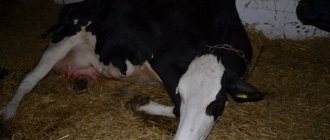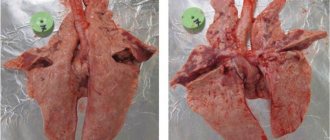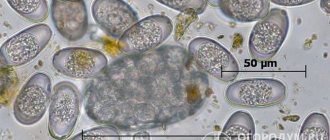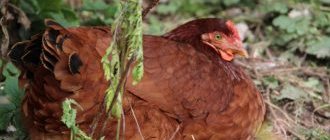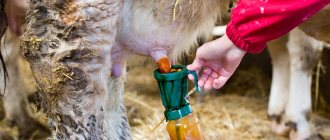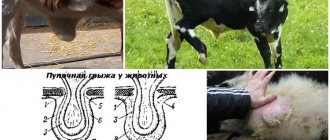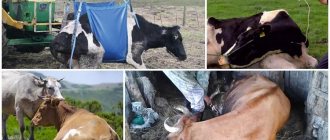What is bovine tuberculosis
Koch stick
Bovine tuberculosis is an infectious disease that occurs in a chronic form, characterized by the formation of certain nodules - tubercles - in the affected organ. The disease is diverse in its course and manifestation, and can affect different organs. Bovine tuberculosis is common in many countries, the severity of the disease continues to increase: at the beginning of the 21st century, the world situation with tuberculosis worsened. The disease causes damage to large and small farms due to a significant decrease in animal productivity, early culling, and high costs for therapeutic measures and preventive measures.
Despite the fact that tuberculosis has been known for a long time, it was described by Hippocrates, effective measures to combat the disease have not yet been found.
Important! French scientist Jean-Antoine Villemin, studying the disease, found evidence that tuberculosis is an infectious disease. And Robert Koch identified the causative agent of the disease - a group of pathogenic microorganisms that later became known as Koch's wand.
Many species of domestic and wild animals, birds and humans are susceptible to tuberculosis. The disease is characterized by widespread occurrence, which depends on many reasons - reduced functions of the immune system, the presence of chronic pathologies in cattle, unbalanced feeding, lack of walking, high humidity in the barn and other provoking factors. That is why it is necessary to identify an infected individual in the herd as soon as possible.
Cattle tuberculosis: general description
The tuberculosis bacillus contributes to the development of human, bovine and avian pathologies. The pathogen is extremely cold-resistant, able to withstand temperatures down to -269 degrees. In dairy products, the infection can remain active for one year.
Attention! In soil, pathogenic bacteria live for two years, in water bodies - at least five, and in old litter and manure even longer.
The pathogenic microorganism dies when exposed to heat and treated with disinfectant solutions.
The bacterium is transmitted by airborne droplets, as well as through feces and urine. In almost 100% of cases, intrauterine infection of the fetus occurs from the mother. Animals are often affected by tuberculosis through feed, in barns, pastures and at watering places.
More often, livestock living in a herd are susceptible to the disease, since in this case there are several factors contributing to the development of tuberculosis:
- Treatment with chemicals, gas contamination of premises.
- Overcrowding, tightness.
- Loud noise, which often causes stress for animals.
- Dampness in the pens, poor ventilation.
- Poor quality food.
Cow
The causative agent of tuberculosis in cattle
The causative agent of tuberculosis in cattle is the microorganism Mycobacterium tuberculosis. It is considered an anaerobic bacterium that does not form spores. The forms of the pathogen are varied, resembling straight or slightly bent sticks. There are rounded shapes, in the form of a chain. There are practically no single organisms in the colony.
Bovine tuberculosis has 3 types of pathogens that lead to infection: bovine, avian and human forms of the microorganism. However, they are able to disguise themselves and be reborn:
- the human strain infects cattle, pigs, and fur-bearing animals; dogs and cats are less commonly infected;
- bovine strain (paratuberculosis) infects cows and is transmitted to humans, as well as domestic and wild animals;
- the avian strain affects birds but is occasionally found in pigs.
The main differences between these forms include different virulence for animal species and humans.
Main routes of infection:
- airborne, in which the disease is quickly transmitted to other cattle, especially in cramped, poorly ventilated areas;
- nutritional (the pathogen enters the body of a healthy animal through the digestive system);
- contact, which is quite rare in cattle;
- intrauterine infection at calving.
The causative agent of tuberculosis is quite viable: in air-dried lungs it remains active for 200 days, in soil and manure for up to 3-4 years. The sun disinfects the bacteria after 2-3 days; in infected cattle carcasses, the microorganism continues its harmful activity for about a year. Heating and boiling have a detrimental effect on Koch's wand. Chemicals disinfect the bacteria no earlier than an hour later, depending on the activity of the substance.
Tuberculinization of livestock
Sources of infection are:
- air contaminated during coughing and sneezing;
- infected milk;
- saliva;
- urine and feces of sick livestock;
- contact with infected wild animals.
Advice! It is necessary to diagnose tuberculosis in cattle in a timely manner and begin therapeutic measures to prevent mass infection and subsequent death of livestock.
Tuberculosis of the cattle udder.
Udder tuberculosis is usually one of the signs of generalized tuberculosis and very rarely can occur as a result of the penetration of tuberculosis infection through the galactogenic route into the udder. Tuberculosis is an infectious disease of domestic and wild animals, usually occurring chronically. The disease is accompanied by the formation in various organs of the animal of specific nodules (tubercles), prone to cheesy degeneration. What is most dangerous is that a person also suffers from tuberculosis, who can become infected from a sick animal .
The causative agent of the disease is Mycobacterium tuberculosis. The tuberculosis bacillus contains fatty wax elements, which is why it is very resistant to the external environment and to the action of disinfectants.
It lasts in manure for 7 months.
in soil up to 1-2 years,
sunlight kills bacteria in sputum only after 72 hours,
in butter and cheeses stored in the cold - 8-10 months.
Heating milk to 55 degrees kills tuberculosis bacteria after 4 hours,
up to 85 degrees in 30 minutes,
when boiling milk - after 3-5 minutes.
Disinfectants have a detrimental effect on tuberculosis bacteria: 5% carbolic acid solution after 24 hours, 5% formaldehyde solution after 12 hours, solution containing 5% active chlorine after 3 hours. All this suggests that in order to prevent this disease, in addition to the mandatory double tuberculinization throughout the year, it is necessary to carry out double disinfection of livestock yards (after driving the cattle to pasture and before placing them in winter stabling). There are three known types of tuberculosis bacillus: human, bovine and avian, which are all varieties of the same species. The main difference between the types is their unequal virulence for individual species of animals and humans. Cattle are mainly infected with bovine, and less commonly human and avian types. Goats and sheep are prone to the bovine type, but goats can be infected by humans and in turn infect them. Pigs become infected with all types of tuberculosis bacteria, depending on which source of the tuberculosis pathogen they come into contact with. Horses are more susceptible to bovine infection. The main source of infection for tuberculosis is animals with tuberculosis, which will shed tuberculosis bacteria in their feces, sputum and milk.
Pathogenesis. Once in the animal’s body with exhaled air or through the digestive tract, tuberculosis bacteria are spread to the lungs and other organs, including. udder. In the process of bacterial proliferation in a particular organ, tissue irritation occurs and the body’s reaction is accompanied by specific inflammation, which is exudative, productive or mixed. In this case, a fresh isolated focus in an organ is called a primary affect. When tuberculosis bacteria penetrate from the primary focus into regional lymph nodes, the pathological process is called the primary complex. Depending on the resistance of the body and the virulence of tuberculosis bacteria, the tuberculosis process in an animal can be benign or malignant. If the animal’s body has good resistance, tuberculosis bacteria that have entered certain organs are surrounded by epithelioid cells, from which giant cells are then formed. This entire group of cells is surrounded by a ring of lymphocytes. Exudate is deposited between the cells and fibrin coagulates. The resulting avascular tuberculous tubercle (granuloma) is encapsulated. Due to the lack of influx of nutrients, tissue cells in the tubercle die and, under the influence of bacterial toxins, a curdled mass is formed, which is subsequently impregnated with lime salts. In such an encapsulated focus, tuberculosis bacteria either die, but most often persist for several years. In an organism with reduced resistance, the process of delimitation and localization of the tuberculosis pathogen is weakly expressed. Due to insufficient encapsulation, melting of the walls of tuberculous nodules occurs. Tuberculosis bacteria enter healthy tissue, which leads to the formation of new small (miliary) nodules. These miliary nodules merge with each other to form large tuberculous foci. When the curdled mass is released from these foci, for example in the lungs through the bronchi, cavities form in the organ. The pathogen spreads through the lymphatic vessels; When the pathogen enters the circulatory system, bacteremia occurs in the body. Bacteria are spread throughout the body, the process generalizes and many organs are affected, including the udder. Tuberculosis of the udder can occur in three forms: single tuberculous foci; diffuse focal points; in the miliary form, when a large number of tiny tuberculous nodules penetrate the entire breast tissue.
Symptoms Regardless of the above forms of udder tuberculosis, the affected quarter or half of the udder increases in volume; When palpating in the udder, you can feel dense, painless lesions of varying sizes or the udder increases in volume evenly (miliary tuberculosis). A characteristic feature of udder tuberculosis is the absence of a local temperature reaction and an enlargement of the supra-udperal lymph node on the affected side of the udder. The animal experiences a gradual decrease in milk production. At the onset of the disease, the quality of milk does not change; Later, as the tuberculous process develops in the udder, the milk becomes watery and contains casein flakes. Cows with udder tuberculosis are immediately handed over to the sanitary slaughterhouse of the meat processing plant for forced slaughter!!!
0 Likes
5937
0 Comments
Please login to comment
Types of tuberculosis in cattle
There are pulmonary and intestinal forms of tuberculosis in cattle based on the location of the pathology. Less commonly diagnosed are lesions of the serous integument, genitalia, udder tuberculosis in cows or a generalized form of the disease.
However, most often the lungs are affected by tuberculosis in cattle. This form of the disease is characterized by a cough and a slight increase in body temperature, while the animal’s appetite and productivity are within normal limits.
As tuberculosis develops, signs of inflammation of the lungs and pleura appear. The cough becomes painful, breathing becomes rapid, accompanied by wheezing. Coughing attacks intensify in the morning and at night, and sputum is produced abundantly. In the chest of cattle, wheezing can be heard upon percussion. A cow experiences severe pain due to pneumonia during palpation. In addition, the animal quickly becomes exhausted, the skin looks dry, the coat loses its shine, and the lymph nodes become enlarged. This leads to a narrowing of the esophagus and subsequent disruption of the rumen and digestion in general.
With tuberculous lesions of the mammary gland in cows, the suprauterine lymph nodes become enlarged. The udder turns red and swells. During milking, watery milk with cottage cheese flakes is released and may contain bloody clots.
Infected individual
When the genitals are affected in bulls, pathologies of the genital organs are noted, including orchitis (inflammation of the testicle), and uveitis (inflammation of the choroid of the eyeball) is often observed. Cows show barrenness, foul-smelling discharge from the genitals, and increased estrus.
Attention! In the generalized form of tuberculosis in cattle, regardless of the affected organ, the disease is progressive and severe.
Types of tuberculosis
Considering the location of infection in the body, it is customary to divide tuberculosis into 2 types:
- Pulmonary.
- Intestinal.
Sometimes tuberculosis affects the cow's udder and genitals.
The most common form of the disease is pulmonary. This type of tuberculosis is characterized by the following symptoms of the disease:
- heat;
- cough.
This form of the disease is not accompanied by digestive problems, lactation also remains normal.
Over time, if treatment measures are not taken, the animal’s condition begins to gradually deteriorate and pneumonia develops. The following are added to the initial signs:
- shortness of breath;
- wheezing in the lungs;
- debilitating cough with strong sputum production;
- pain reaction when pressing on the lung area;
- weight loss;
- dry skin;
- deterioration in the appearance of fur;
- enlarged lymph nodes.
When a cow develops udder inflammation, the symptoms of the disease are as follows:
- inflammation of the lymph nodes located above the udder;
- swelling of the udder with changes in skin color;
- When milking, the milk is liquid, similar to water, with admixtures of blood and curdled formations.
Tuberculosis of the genital organs is accompanied by inflammation of the testicles in bulls. Cows cannot become pregnant, an unpleasant, unnatural odor comes from the genitals, and there is an increased desire to hunt.
It should be noted that there is a generalized form of tuberculosis. This is the name given to the condition of an animal when the disease progresses rapidly and is accompanied by severe symptoms.
Symptoms of tuberculosis in cattle
Typically, tuberculosis in cattle occurs in a chronic form, in calves most often in an acute form. Most infected animals do not differ from healthy animals in general condition, behavior, and appearance. The appearance of symptoms and pronounced forms of the disease indicates a long-standing infection.
In the development of tuberculosis in cattle, several stages of the disease are noted:
- Primary tuberculosis. It has several forms - from the initial complex and the period of early generalization.
- Secondary pathology. Has a period of late generalization or tuberculosis of a specific organ.
Primary tuberculosis is the stage of the disease that occurs after infection and is manifested by the primary complex.
The primary complex, which is localized in several systems of the cattle body at once, is called complex. Early generalization of the disease - its spread throughout the body. Secondary tuberculosis develops as a continuation of the primary one or occurs as a result of repeated infection (reinfection).
There are open (active) forms of tuberculosis in cattle and closed (latent) forms of the disease. With open tuberculosis, the pathogen is released into the environment with feces, urine, milk, and sputum. Tuberculosis of the intestines, uterus, and mammary gland is always considered an open form. The closed form of the disease is characterized by the presence of foci without release of the pathogen into the external environment.
Cattle tuberculosis in the photo
Despite the fact that the disease often occurs in a latent form, the animal owner should be alert to the following signs of tuberculosis in cattle:
- dyspnea;
- increased body temperature;
- sudden depletion of the animal;
- loss of appetite;
- decreased productivity;
- dry skin;
- cough, sputum production;
- mucus from the nose, increased salivation;
- enlargement of the retropharyngeal glands;
- disruption of the digestive system.
With generalized tuberculosis, an increase in lymph nodes throughout the body of cattle is noted.
Diagnosis of tuberculosis in cattle
Diagnostic measures should include clinical, laboratory, pathological methods, as well as an allergic intradermal tuberculin test. It is necessary to exclude diseases with similar symptoms: pericarditis, contagious pleuropneumonia, pasteurellosis, pseudotuberculosis, helminthic infestations.
Attention! When diagnosing tuberculosis in cattle, it is important to take into account epidemiological data. This will make it possible to identify ways of introducing the pathogen into the farm, the course of the disease and the degree of spread among cattle.
The main and most reliable method for diagnosing tuberculosis in cattle, other animal species and humans is an allergy test. To do this, use the classic version of tuberculin, which contains dead cultures of the tuberculosis bacillus. The drug can be administered to cattle subcutaneously or by eye drops. Tuberculinization should be carried out 2 times a year before animals are taken out to pasture in the spring and before switching to winter housing. As for young animals, each calf is tested at two months of age. After administration of the drug, it is necessary to monitor the reaction to tuberculin in cattle after 72 hours. It is counted if in cows the skin fold differs in thickness by more than 3 mm, in bulls - if there is edema. In addition, you need to monitor the reaction of the skin (swelling, redness, temperature). Sometimes, to clarify the diagnosis of tuberculosis and identify a nonspecific reaction of the body, cattle are subjected to differential diagnosis using a simultaneous test.
Diagnostics in calves
Also important is the clinical method of diagnosing cattle, in which a veterinarian pays attention to the clinical symptoms of the disease.
Diagnostics
Several diagnostic methods are used for suspected tuberculosis in cattle:
- Clinical researches.
- Lab tests.
- Pathoanatomical autopsy.
The initial goal of the study is to rule out diseases with similar symptoms. Among them are pericarditis, pasteurellosis, pseudotuberculosis and helminthic infestations.
It is important to try to determine the source of infection of the cow with tuberculosis and the nature of the disease. If a cow exhibits some symptoms and suspicions of tuberculosis, the diagnosis can be clarified using laboratory tests.
Treatment of tuberculosis in cattle
Veterinary medicine does not have an effective treatment against bovine tuberculosis. Thus, it is impossible to cure infected animals. But according to the results of a study of the entire livestock, this farm is classified as unfavorable; a number of health-improving measures are carried out in the herd.
The herd taken under control by decision of the district administration is subject to some restrictions that will prevent the spread of infection. Also, a specialist is assigned to the farm who will monitor the strict implementation of instructions for combating tuberculosis in the cattle herd.
Health activities on farms are carried out in the following ways:
- Regular laboratory tests to identify all infected cattle. Inspections are carried out at intervals of 60 days. If infected cows are found, they should be culled immediately. Tests are carried out until all animals in the herd show a negative result. Only in this case will the livestock be subject to quarantine for bovine tuberculosis, and the farm will be considered healthy.
- Complete replacement of the cattle herd with healthy animals with mandatory disinfection of the barn and surrounding areas. This method is effective if the percentage of cows that reacted positively is too high (more than 15% of the total number of heads in the herd). Then the farm is quarantined.
Measures to improve livestock health
Measures to completely replace the herd include the following measures:
- all animals, including young animals, are sent for slaughter;
- milk obtained from all cows is boiled for about 5 minutes at 90 °C before disposal;
- the barn is cleaned of dirt, manure, and the old covering is removed;
- the entire area is treated with a solution of caustic salt and formaldehyde;
- garbage is transported outside the farm, as well as manure and topsoil;
- All equipment must be recycled.
After all the work, the barn is restored, the rest of the premises, the surrounding area, drinking bowls and feeders are installed. Then everything is re-treated with disinfectant solutions, after which samples are taken for the presence of the pathogen. After receiving negative results, the quarantine is lifted, the owner can purchase a new herd of cattle from those farms that are listed as safe by the veterinary service. The new herd is also tested with tuberculin.
Advice! If cattle tuberculosis is detected on a certain farm, quarantine is also imposed on the pasture where the affected herd was grazed. In the future, livestock can be allowed on it no earlier than after 2 years.
Tubercles
Treatment and pest control
Sick animals cannot be treated. They can infect the entire herd and the people around it. Such animals are sent for slaughter.
After the farm where the cow was found sick with tuberculosis is under quarantine. Tuberculin tests are done regularly. If a new sick individual is discovered, it is immediately eliminated. All this lasts as long as patients are identified. The premises are constantly disinfested and constantly ventilated.
If more than 20% are infected, then they move on to radical methods:
- All diagnostic procedures are removed.
- All cattle go to slaughter.
- The milk is boiled for 5 to 10 minutes.
- The premises where the cows were are being cleaned. Then the floor is torn off and everything is treated with a disinfectant solution (formaldehyde, caustic salt, lime with 5% chlorine).
- Everything that remains from the animals (including the torn off flooring) is disposed of.
- If there was no cement under the floor covering, but only earth, then a 20-centimeter layer is removed and sent to a veterinary laboratory, where it is examined. Feces are also transported there. Contaminated feces should not be used for fertilizer.
After everything, a new floor is laid, new feeders are attached and everything is re-disinfected. A new farm is being imported.
All livestock must undergo tuberculin testing.
It is possible to bring new cows out to graze in the same place where those infected with tuberculosis grazed only after two years.
Pathological changes in tuberculosis in cattle
When autopsying a cow infected with tuberculosis, the following changes are noted:
- some nodules (tubercles) in organs and tissues ranging in size from several mm to 10 cm, which have a gray color with a dense structure;
- changes in serous tissue in the abdominal cavity;
- tubercles and ulcers of the mucous membranes;
- suppuration, cavities;
- disturbance of gas exchange in the lungs;
- pulmonary necrosis with purulent formations;
- severe exhaustion;
- signs of bronchopneumonia;
- inflammatory processes in the lymph nodes;
- pathological changes in the liver, kidneys, heart, bone marrow.
The main sign of tuberculosis during autopsy of an animal is the presence of tubercles, which can be located in various areas of the lesion. When excision of the nodule, a layered, curd-like structure is visible.
Prevention of tuberculosis in cattle
Quarantine on the farm
The instructions for combating bovine tuberculosis provide for the implementation of certain sanitary and veterinary standards. Cattle owners need to:
- register the animals with the veterinary service; the tag with the number should be kept throughout the life of the animal;
- movement of individuals, purchase and sale must be carried out with the permission of veterinary authorities;
- carefully prepare feed to avoid contamination;
- keep all new animals in quarantine for a month;
- at the slightest suspicion of tuberculosis, notify veterinary specialists;
- promptly vaccinate and test cattle for this disease;
- comply with all standards of feeding, keeping and caring for livestock;
- take measures to combat rodents;
- enrich the cattle diet with vitamins and microelements;
- promptly identify and reject infected individuals;
- check meat at the slaughterhouse;
- monitor the health status of farm personnel;
- introduce quarantine if necessary, follow all rules in accordance with the instructions.
In addition to these measures, the BCG vaccine is used to develop immunity and as a specific prophylaxis. It is administered to animals at intervals of 14 days. Such strict measures are necessary, since bovine tuberculosis cannot be treated, often occurs in a latent form and causes enormous economic damage to farms. Therefore, preventive measures and diagnosis of the disease are extremely important.
Is tuberculosis transmitted to humans from cattle?
Tuberculosis is a highly contagious disease, and the bovine strain is also dangerous for humans. There are several ways of transmitting the pathogen from a sick cattle to humans:
- Airborne. A person can become infected, especially with the open form of tuberculosis, when the animal releases microparticles of mucus and bacteria into the environment. If the barn is at high temperature, humid, and there is no ventilation, then Koch's bacillus can remain in the air for a long time and be viable.
- Meat and dairy products. With bovine tuberculosis, meat and milk contain a huge number of pathogens. By consuming products without prior heat treatment, a person may become infected.
- Contact. When suffering from tuberculosis, an animal releases feces, urine, and sputum into the environment. Thus, livestock bedding becomes contaminated. Workers with skin lesions may become infected when cleaning the barn.
Milk should be boiled
Infection can also occur from birds, but the disease will proceed in a different way.
Important! When buying milk from private individuals, there is a risk of contracting tuberculosis. Therefore, it should be thoroughly boiled before use.
Is it possible to drink milk if the cow has tuberculosis?
The milk of infected cows is extremely dangerous for humans, especially for children. Infection is 90-100% possible. Koch's bacillus is resistant to acidic environments. Therefore, even in sour milk it remains viable for 20 days, in cheeses and butter for up to 1 year, in frozen products for up to 6-7 years.
Milk from healthy cows, but obtained from an unfavorable farm, is processed at a temperature of 90 °C for 5 minutes. Contaminated milk is strictly prohibited for consumption. However, after heat treatment, it is permissible to use it for fattening animals on the farm.
Milk from sick animals differs in composition. The amount of albumin and globulin in it doubles, the fat content decreases, and the viscosity increases. Such milk will not make cheese, yogurt will be watery, and kefir will be uneven.
The quality of meat and dairy products is monitored by veterinary and sanitary examination, which allows products of proper quality to be sold. In the presence of generalized tuberculosis, all carcasses, by order of the VSE, are disposed of, including bones and internal organs. Carcasses with a tuberculosis focus in any one organ or lymph node are sent for processing into sausages or canned food, in compliance with all veterinary standards. Cattle organs affected by tuberculosis are sent for disposal.
There is no place for rods in milk: the truth about cow tuberculosis
07/10/2017 When hearing the words “tuberculosis, consumption, dryness,” the image of thin young ladies of past centuries comes to mind. But even in our time of antibiotics, mandatory vaccinations and early diagnosis, the disease has not been overcome.
Mycobacterium tuberculosis is incredibly tenacious in acidic environments. Therefore, she is quite comfortable in dairy products. New species have also appeared that are not afraid of disinfectants and drugs (multiresistant).
To prevent tuberculosis, it is now not enough to lead a healthy lifestyle and be regularly examined by doctors. It is important to pay attention to what we eat. Milk and dairy products are the basis of nutrition for children, the elderly and lovers of a healthy lifestyle. Tasty, healthy and affordable. But, alas, it is not always safe.
The possibility of contracting tuberculosis is not far-fetched. Almost everyone who drinks contaminated milk suffers from extrapulmonary forms of the disease. Children are especially at risk. This is why milk for baby food undergoes such strict testing in factories. But mothers and grandmothers believe that store-bought milk contains “one powder.” Therefore, they prefer milk and cottage cheese from grandmothers. Not only is such a product unknown when, with what technology and by whom it was produced, in what conditions it was stored before sale, but there is also a mystery: is the cow sick? From which of these sellers have you seen quality certificates, permits from veterinary services, or at least an animal passport with health notes and mandatory vaccinations? They are more likely to start swearing about quality or arguing with you, rather than showing you documents. So is it worth the risk?
What is the difference between the milk of healthy and sick cows?
The milk of sick animals is different from the milk of healthy cows or goats. The amount of proteins (albumin and globulin) doubles in it. These substances are responsible for the body’s immunity and pass from milk into the blood without changes. For any illness, the amount of albumin and globulin increases. But this does not mean that milk becomes healthier or acquires the properties of immunomodulators.
In such raw materials, the fat content decreases and the viscosity increases. It will be difficult for technologists at the plant to make a high-quality product from milk from sick cows: cheese will not turn out, yogurt will turn out watery, and kefir will be heterogeneous.
Is it possible to visually identify milk from a tuberculous cow without a specialist? Technologists and cheese makers trust only laboratory methods, but experienced craftsmen or milkmaids note the wateriness of the milk, a greenish or bluish tint, and the presence of flakes.
Milk from a sick cow: don’t throw it away, don’t drink it
Infectious disease specialists sadly state that 1 in 10 cases of extrapulmonary tuberculosis occurs due to ingestion of contaminated milk or dairy products. Mycobacterium (the causative agent of the disease), once in the body, does not spare any organ. In addition to the traditional lungs, pathology is rapidly developing everywhere except nails and hair. For example, with kidney damage, people begin to be treated for pyelonephritis with folk remedies. Because of this, time is wasted. Even the reproductive sphere is under attack. In more than 25% of cases of infertility, mycobacterium is present, which thrives on the mucous membrane of the genital organs.
We are accustomed to the fact that tuberculosis is a threat only to the lungs. But the data from ophthalmologists will shock you. More than half of cases of sudden blindness are explained by damage to the eyeball, mucous membrane or optic nerve. Isn't it true that the data is not very optimistic? So think about the foods you eat. Including the quality of milk and dairy products.
The cause of extrapulmonary tuberculosis in most cases is food. Especially fresh milk from sick cows and goats. Yes, it contains a lot of vitamins and substances that have antibacterial properties. But the healing power of milk cannot defeat the Koch wand. And the nutrient medium of fats, proteins and calcium is ideal for the causative agent of the disease.
The tuberculosis bacillus lives in milk for 10 days, and in yogurt, kefir, and fermented baked milk for up to 3 weeks. But the record was broken by butter and cheeses. In such a nutrient medium, the tuberculosis bacillus remains active and dangerous for 1 year. Therefore, veterinarians and dairy industry technologists are categorical: buy milk and dairy products only from certified sellers (large farms, agricultural holdings and dairies). The hryvnia saved when purchasing “homemade” milk from your grandmother does not cover even a tenth of the cost of anti-tuberculosis therapy. Really, it's a reason to think, isn't it?
What to do with milk?
On farms, the livestock of VRH or goats regularly undergo medical examination against tuberculosis. Milk from sick animals is immediately destroyed. If the cow reacts positively to the pathogen, but does not show symptoms of the disease, then the milk is pasteurized at a temperature of 85 ° C
at least 30 minutes. Then the raw materials are used to feed young animals.
How to protect yourself and your cow from tuberculosis? For this:
· workers of a farm, milk collection point or dairy plant annually undergo fluorography and undergo a medical examination for tuberculosis;
· people with an active form of the disease are suspended from work;
· for fattening it is better not to use food waste from tuberculosis dispensaries or sanatoriums without special treatment (pasteurization);
· buy milk and dairy products only from certified sellers and specialized stores and supermarkets;
· refuse to purchase milk or dairy products from hand, no matter how the sellers lure you in and set a low price.
